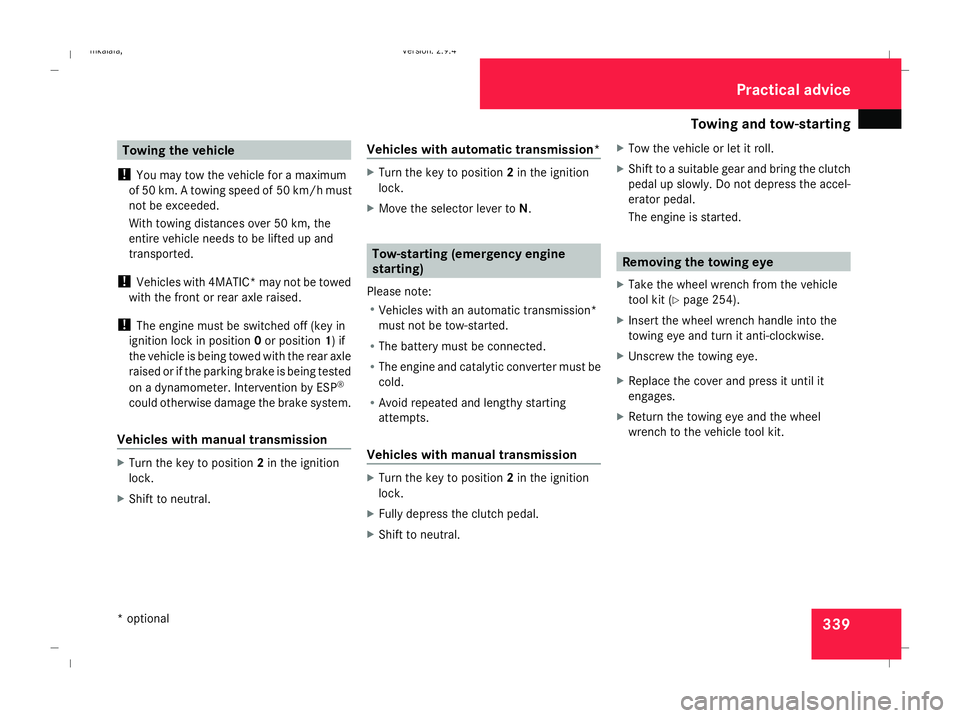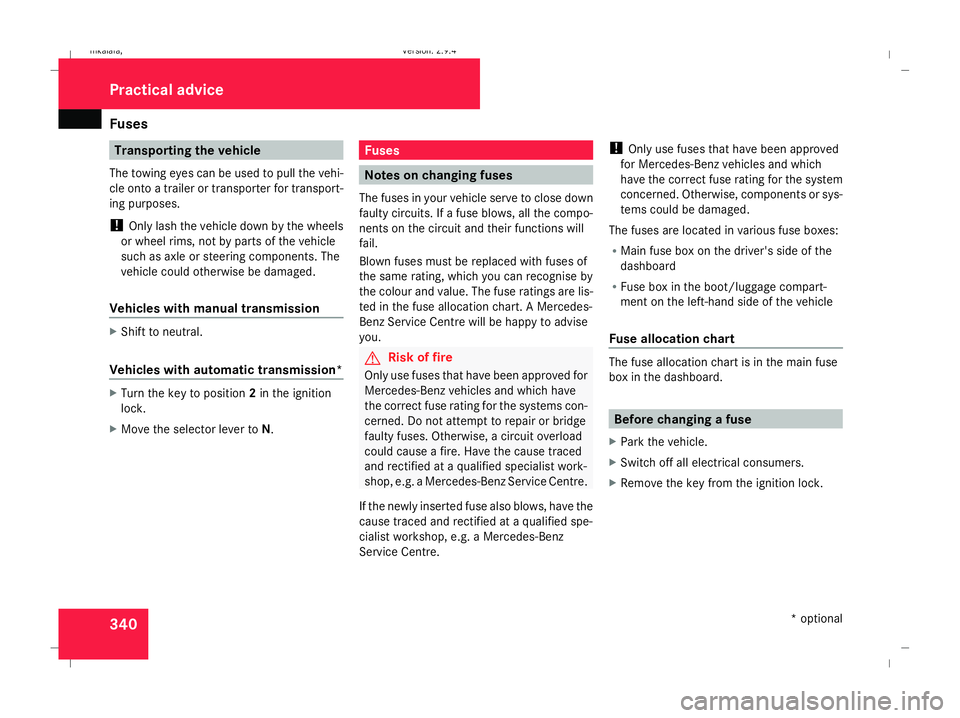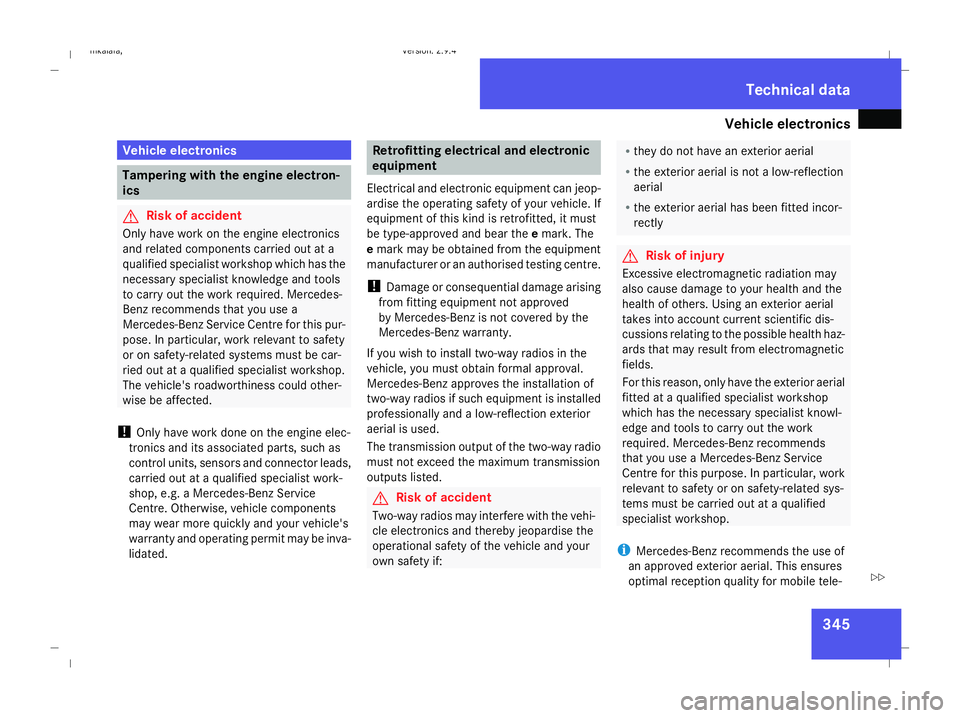Page 342 of 401

Towing and tow-starting
339Towing the vehicle
! You may tow the vehicle for a maximum
of 50 km. A towing speed of 50 km/h must
not be exceeded.
With towing distances over 50 km, the
entire vehicle needs to be lifted up and
transported.
! Vehicles with 4MATIC* may not be towed
with the front or rear axle raised.
! The engine must be switched off (key in
ignition lock in position 0or position 1) if
the vehicle is being towed with the rear axle
raised or if the parking brake is being tested
on a dynamometer. Intervention by ESP ®
could otherwise damage the brake system.
Vehicles with manual transmission X
Turn the key to position 2in the ignition
lock.
X Shift to neutral. Vehicles with automatic transmission* X
Turn the key to position 2in the ignition
lock.
X Move the selector lever to N. Tow-starting (emergency engine
starting)
Please note:
R Vehicles with an automatic transmission*
must not be tow-started.
R The battery must be connected.
R The engine and catalytic converter must be
cold.
R Avoid repeated and lengthy starting
attempts.
Vehicles with manual transmission X
Turn the key to position 2in the ignition
lock.
X Fully depress the clutch pedal.
X Shift to neutral. X
Tow the vehicle or let it roll.
X Shift to a suitable gear and bring the clutch
pedal up slowly. Do not depress the accel-
erator pedal.
The engine is started. Removing the towing eye
X Take the wheel wrench from the vehicle
tool kit ( Ypage 254).
X Insert the wheel wrench handle into the
towing eye and turn it anti-clockwise.
X Unscrew the towing eye.
X Replace the cover and press it until it
engages.
X Return the towing eye and the wheel
wrench to the vehicle tool kit. Practical advice
* optional
211_AKB; 2; 5, en-GB
mkalafa
,V ersion: 2.9.4
2008-02-29T16:57:07+01:00 - Seite 339 ZDateiname: 6515_3416_02_buchblock.pdf; preflight
Page 343 of 401

Fuses
340 Transporting the vehicle
The towing eyes can be used to pull the vehi-
cle onto a trailer or transporter for transport-
ing purposes.
! Only lash the vehicle down by the wheels
or wheel rims, not by parts of the vehicle
such as axle or steering components. The
vehicle could otherwise be damaged.
Vehicles with manual transmission X
Shift to neutral.
Vehicles with automatic transmission* X
Turn the key to position 2in the ignition
lock.
X Move the selector lever to N. Fuses
Notes on changing fuses
The fuses in your vehicle serve to close down
faulty circuits. If a fuse blows, all the compo-
nents on the circuit and their functions will
fail.
Blown fuses must be replaced with fuses of
the same rating, which you can recognise by
the colour and value. The fuse ratings are lis-
ted in the fuse allocation chart. A Mercedes-
Benz Service Centre will be happy to advise
you. G
Risk of fire
Only use fuses that have been approved for
Mercedes-Benz vehicles and which have
the correct fuse rating for the systems con-
cerned. Do not attempt to repair or bridge
faulty fuses. Otherwise, a circuit overload
could cause a fire. Have the cause traced
and rectified at a qualified specialist work-
shop, e.g. a Mercedes-Benz Service Centre.
If the newly inserted fuse also blows, have the
cause traced and rectified at a qualified spe-
cialist workshop, e.g. a Mercedes-Benz
Service Centre. !
Only use fuses that have been approved
for Mercedes-Benz vehicles and which
have the correct fuse rating for the system
concerned. Otherwise, components or sys-
tems could be damaged.
The fuses are located in various fuse boxes:
R Main fuse box on the driver's side of the
dashboard
R Fuse box in the boot/luggage compart-
ment on the left-hand side of the vehicle
Fuse allocation chart The fuse allocation chart is in the main fuse
box in the dashboard.
Before changing a fuse
X Park the vehicle.
X Switch off all electrical consumers.
X Remove the key from the ignition lock. Practical advice
* optional
211_AKB; 2; 5, en-GB
mkalafa,
Version: 2.9.4 2008-02-29T16:57:07+01:00 - Seite 340Dateiname: 6515_3416_02_buchblock.pdf; preflight
Page 348 of 401

Vehicle electronics
345Vehicle electronics
Tampering with the engine electron-
ics
G
Risk of accident
Only have work on the engine electronics
and related components carried out at a
qualified specialist workshop which has the
necessary specialist knowledge and tools
to carry out the work required. Mercedes-
Benz recommends that you use a
Mercedes-Benz Service Centre for this pur-
pose. In particular, work relevant to safety
or on safety-related systems must be car-
ried out at a qualified specialist workshop.
The vehicle's roadworthiness could other-
wise be affected.
! Only have work done on the engine elec-
tronics and its associated parts, such as
control units, sensors and connector leads,
carried out at a qualified specialist work-
shop, e.g. a Mercedes-Benz Service
Centre. Otherwise, vehicle components
may wear more quickly and your vehicle's
warranty and operating permit may be inva-
lidated. Retrofitting electrical and electronic
equipment
Electrical and electronic equipment can jeop-
ardise the operating safety of your vehicle. If
equipment of this kind is retrofitted, it must
be type-approved and bear the emark. The
e mark may be obtained from the equipment
manufacturer or an authorised testing centre.
! Damage or consequential damage arising
from fitting equipment not approved
by Mercedes-Benz is not covered by the
Mercedes-Benz warranty.
If you wish to install two-way radios in the
vehicle, you must obtain formal approval.
Mercedes-Benz approves the installation of
two-way radios if such equipment is installed
professionally and a low-reflection exterior
aerial is used.
The transmission output of the two-way radio
must not exceed the maximum transmission
outputs listed. G
Risk of accident
Two-way radios may interfere with the vehi-
cle electronics and thereby jeopardise the
operational safety of the vehicle and your
own safety if: R
they do not have an exterior aerial
R the exterior aerial is not a low-reflection
aerial
R the exterior aerial has been fitted incor-
rectly G
Risk of injury
Excessive electromagnetic radiation may
also cause damage to your health and the
health of others. Using an exterior aerial
takes into account current scientific dis-
cussions relating to the possible health haz-
ards that may result from electromagnetic
fields.
For this reason, only have the exterior aerial
fitted at a qualified specialist workshop
which has the necessary specialist knowl-
edge and tools to carry out the work
required. Mercedes-Benz recommends
that you use a Mercedes-Benz Service
Centre for this purpose. In particular, work
relevant to safety or on safety-related sys-
tems must be carried out at a qualified
specialist workshop.
i Mercedes-Benz recommends the use of
an approved exterior aerial. This ensures
optimal reception quality for mobile tele- Technical data
211_AKB; 2; 5, en-GB
mkalafa,
Version: 2.9.4
2008-02-29T16:57:07+01:00 - Seite 345 ZDateiname: 6515_3416_02_buchblock.pdf; preflight
Page 352 of 401
Engine
349E 350 E 350 4MATIC E 500 E 500 4MATIC
Displacement
3,498 cm
3 3,498 cm
3 5,461 cm
3 5,461 cm
3 Maximum engine
speed 6,500 rpm 6,500 rpm 6,500 rpm 6,500 rpm
E 63 AMG E 200 CDI E 220 CDI E 280 CDI
Rated output 378 kW (514 bhp) 100 kW (136 bhp) 125 kW (170 bhp) 140 kW (190 bhp)
At engine speed 6,800 rpm 3,800 rpm 3,800 rpm 4,000 rpm
Rated torque 630 Nm 340 Nm 400 Nm
400 Nm (440 Nm
38
) At engine speed 5,200 rpm 1,800 – 2,600 rpm 2,000 rpm 1,400 – 3,200 rpm
(1,400 - 2,800 rpm 38
) Number of cylinders 8 4 4 6
Displacement
6,208 cm
3 2,148 cm
3 2,148 cm
3 2,987 cm
3 Maximum engine
speed 7,200 rpm 5,000 rpm 5,000 rpm 4,500 rpm
38
Only on vehicles with automatic transmission. Technical data
211_AKB; 2; 5, en-GB
mkalafa,
Version: 2.9.4 2008-02-29T16:57:07+01:00 - Seite 349 ZDateiname: 6515_3416_02_buchblock.pdf; preflight
Page 356 of 401
Performance
3535-speed
Automatic transmis- sion* E 200 CDI E 220 CDI E 280 CDI 4MATIC E 320 CDI 4MATIC
Maximum speed Saloon 211 km/h 225 km/h 234 km/h 244 km/h
Estate 200 km/h 218 km/h 226 km/h 236 km/h
6-speed
Manual transmission E 200 KOMPRESSOR E 230 E 280
Maximum speed Saloon 236 km/h 248 km/h 250 km/h
Estate 225 km/h 233 km/h 246 km/h
6-speed
Manual transmission E 200 CDI E 220 CDI E 280 CDI
Maximum speed Saloon 214 km/h 227 km/h 241 km/h
Estate 202 km/h 218 km/h 231 km/h Technical data
* optional
211_AKB; 2; 5, en-GB
mkalafa,
Version: 2.9.4 2008-02-29T16:57:07+01:00 - Seite 353 ZDateiname: 6515_3416_02_buchblock.pdf; preflight
Page 357 of 401
Performance
354 Acceleration from 0 to 100 km/h
E 200 KOMPRESSOR E 230 E 280 E 280 4MATIC
6-speed manual
transmission Saloon 9.1 seconds 8.9 seconds 7.3 seconds –
Estate 9.5 seconds 9.9 seconds 8.1 seconds –
5-speed automatic
transmission Saloon 9.4 seconds – – 7.8 seconds
Estate 9.7 seconds – – 8.3 seconds
7-speed automatic
transmission Saloon – 9.1 seconds 7.3 seconds –
Estate – 9.9 seconds 7.9 seconds –
E 350 E 350 4MATIC E 500 E 500 4MATIC
5-speed automatic
transmission Saloon – 7.1 seconds – 5.5 seconds
Estate – 7.4 seconds – 5.7 seconds
7-speed automatic
transmission Saloon 6.9 seconds – 5.3 seconds –
Estate 7.1 seconds – 5.4 seconds –Technical data
211_AKB; 2; 5, en-GB
mkalafa,
Version: 2.9.4 2008-02-29T16:57:07+01:00 - Seite 354Dateiname: 6515_3416_02_buchblock.pdf; preflight
Page 358 of 401
Performance
355E 200 CDI E 220 CDI E 280 CDI
6-speed manual
transmission Saloon 9.9 seconds 8.4 seconds 8.6 seconds
Estate 10.5 seconds 9.1 seconds 9.1 seconds
5-speed automatic
transmission Saloon 9.9 seconds 8.6 seconds –
Estate 10.7 seconds 9.1 seconds –
7-speed automatic
transmission Saloon – – 7.6 seconds
Estate – – 8.2 seconds
E 280 CDI 4MATIC E 320 CDI E 320 CDI 4MATIC E 420 CDI
5-speed automatic
transmission Saloon 8.2 seconds – 7.4 seconds –
Estate 9.0 seconds – 8.1 seconds –
7-speed automatic
transmission Saloon – 6.8 seconds – 6.1 seconds
Estate – 7.3 seconds – –
E 350 CGI E 300 Bluetec E 63 AMG
7-speed automatic
transmission Saloon 6.8 seconds 7.2 seconds 4.5 seconds
Estate 7.0 seconds – 4.6 secondsTechnical data
211_AKB; 2; 5, en-GB
mkalafa,
Version: 2.9.4 2008-02-29T16:57:07+01:00 - Seite 355 ZDateiname: 6515_3416_02_buchblock.pdf; preflight
Page 379 of 401
Trailer coupling*
376 Trailer loads
All models except
E 200/E 230 62 E 200
E 230
Permissible trailer load, braked
63 Saloon 1,900 kg
1,700 kg
64 Estate
Vehicles with manual transmission
Vehicles with automatic transmission* 1,900 kg
2,100 kg
1,700 kg
64
2,100 kg Permissible trailer load, unbraked Saloon 750 kg 750 kg
Estate 750 kg 750 kg
Maximum drawbar noseweight
65 Saloon 76 kg 76 kg
Estate 84 kg 84 kg
62
The E 63 AMG model cannot be used to tow a trailer.
63 At a minimum gradient-climbing capability of 12% from a standstill
64 At a minimum gradient-climbing capability of 8 %: 1,900 kg
65 The drawbar noseweight is not included in the trailer load. Technical data
* optional
211_AKB; 2; 5, en-GB
mkalafa
,V ersion: 2.9.4
2008-02-29T16:57:07+01:00 - Seite 376 Dateiname: 6515_3416_02_buchblock.pdf; preflight